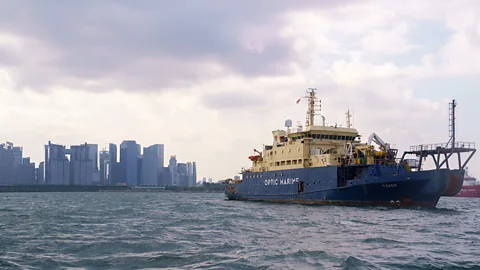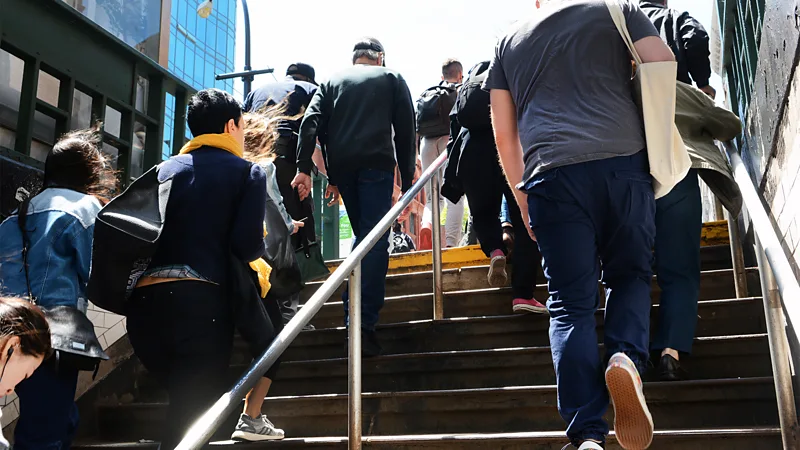The deep-sea 'emergency service' that keeps the internet running

Ninety-nine percent of the world's digital communications rely on subsea cables. When they break, it could spell disaster for a whole country's internet. How do you fix a fault at the bottom of the ocean?
It was a little after 17:00 on 18 November 1929 when the ground began to shake. Just off the coast of Burin Peninsula, a finger-like protrusion on the south of Newfoundland, Canada, a 7.2 magnitude earthquake disturbed the evening's peace. Residents noticed only a little damage at first – a few toppled chimney pots.
But out at sea, an unseen force was moving. By around 19:30, a 13m-high (43ft) tsunami made landfall on the Burin Peninsula. In total, 28 people lost their lives as a result of drowning or injuries caused by the wave.
The earthquake was devastating for the local communities, but it also had a long-lasting effect further out at sea. It had triggered a submarine landslide. People did not realise this at the time, historical records suggest, because no one knew such underwater landslides existed. When sediment is disturbed by earthquakes and other geological activity it makes the water denser, causing it to flow downwards like an avalanche of snow down a mountain. The submarine landslide – called a turbidity current – flowed more than 1,000km (621 miles) away from the earthquake's epicentre on the Laurentian Continental Slope at speeds between 50 and 70 knots (57-80mph).
Although the landslide was not noticed at the time, it left a tell-tale clue. In its way lay the latest in communication technology at the time: transatlantic subsea cables. And those cables broke. Twelve of them were snapped in a total of 28 places. Some of the 28 breaks happened almost synchronously with the earthquake. But the other 16 breaks happened over a much longer period, as the cables snapped one after the other in a kind of mysterious ripple pattern, from 59 minutes after the earthquake to 13 hours and 17 minutes later, and over 500km (311 miles) away from the epicentre. (Read more about the undersea rivers that threaten the world's internet.)
If they'd all been snapped by the quake itself, the cables would have all broken at the same time – so scientists began to wonder, why didn't they? Why did they break one after the other?
It wasn't until 1952 that researchers pieced together why the cables broke in sequence, over such a large area, and at intervals that seemed to slow with distance from the epicentre. They figured out that a landslide smashed through them – the snapping cables traced its movement across the seafloor. Until that point, no one knew of the existence of turbidity currents. Because these cables broke, and because there was a record of the time they broke, they helped in the understanding of ocean movements above and below the surface. They caused a complex repair job, but also became accidental scientific instruments, recording a fascinating natural phenomenon far out of human sight.
Over the following decades, as the global web of deep-sea cables expanded, their repair and maintenance resulted in other surprising scientific discoveries – opening up entirely new worlds and allowing us to spy on the seabed like never before, while also allowing us to communicate at record speed. At the same time, our daily lives, incomes, health and safety have also become more and more dependent on the internet – and ultimately, this complex network of undersea cables. So what happens when they break?

How our data travels
There are 1.4 million km (870,000 miles) of telecommunication cables on the seafloor, covering every ocean on the planet. Laid end to end, these cables would span the diameter of the Sun, and are responsible for the transfer of 99% of all digital data. But for something so important, they are surprisingly slender – often little more than 2cm in diameter, or about the width of a hosepipe.
A repeat of the 1929 mass cable outage would have significant impacts on communication between North America and Europe. However, "for the most part, the global network is remarkably resilient," says Mike Clare, the International Cable Protection Committee's marine environmental advisor who researches the impacts of extreme events on submarine systems. "There are 150 to 200 instances of damage to the global network each year. So if we look at that against 1.4 million km, that's not very many, and for the most part, when this damage happens, it can be repaired relatively quickly."
How does the internet run on such slim cables and avoid disastrous outages?
Since the first cables were laid in the 19th Century, they have been exposed to extreme environmental events, from submarine volcanic eruption to typhoons and floods. But the biggest cause of damage is not natural.
Most faults, with figures varying 70-80% depending on where you are in the world, relate to accidental human activities like the dropping of anchors or dragging of trawler boat nets, which snag on the cables, says Stephen Holden, head of maintenance for Europe, the Middle East and Africa at Global Marine, a subsea engineering firm who respond to subsea cable repairs. These usually occur in depths of 200-300m (but commercial fishing is increasingly pushing into deeper waters – in some places, 1,500m in the Northeast Atlantic). Only 10-20% of faults worldwide relate to natural hazards, and more frequently relate to cables wearing thin in places where currents cause them to rub against rocks, causing what are called "shunt faults", says Holden
(The idea that cables break because sharks bite through them is now a bit of an urban legend, adds Clare. "There were instances of sharks damaging cables, but that's long gone because the cable industry uses a layer of Kevlar to strengthen them.")
Cables have to be kept thin and light in deeper waters, though, to aid with recovery and repair. Hauling a large, heavy cable up from thousands of metres below sea level would put a huge amount of strain on it. It's the cables nearer the shoreline that tend to be better armoured because they are more likely to be snagged by nets and anchors.
An army of stand-by repair ships
If a fault is found, a repair ship is dispatched. "All these vessels are strategically placed around the world to be 10-12 days from base to port," says Mick McGovern, deputy vice-president for marine operations at Alcatel Submarine Networks. "You have that time to work out where the fault is, load the cables [and the] repeater bodies" – which increase the strength of a signal as it travels along the cables. "In essence when you think how big the system is, it's not long to wait," he says.
While it took nine months to repair the last of the subsea cable damage caused by the 1929 Newfoundland earthquake, McGovern says a modern deep-water repair should take a week or two depending on the location and the weather. "When you think about the water depth and where it is, that's not a bad solution."
That does not mean an entire country's internet is then down for a week. Many nations have more cables and more bandwidth within those cables than the minimum required amount, so that if some are damaged, the others can pick up the slack. This is called redundancy in the system. Because of this redundancy, most of us would never notice if one subsea cable was damaged – perhaps this article would take a second or two longer to load than normal. In extreme events, it can be the only thing keeping a country online. The 2006 magnitude 7 earthquake off the coast of Taiwan, severed dozens of cables in the South China Sea – but a handful remained online.
To repair the damage, the ship deploys a grapnel, or grappling hook, to lift and snip the cable, pulling one loose end up to the surface and reeling it in across the bow with large, motorised drums. The damaged section is then winched into an internal room and analysed for a fault, repaired, tested by sending a signal back to land from the boat, sealed and then attached to a buoy while the process is repeated on the other end of the cable.
Once both ends are fixed, each optical fibre is spliced together under microscope to make sure that there is good connection, and then they are sealed together with a universal joint that is compatible with any manufacturer's cable, making life easier for international repair teams, McGovern says.

The repaired cables are lowered back into the water, and in shallower waters where there might be more boat traffic, they are buried in trenches. Remotely operated underwater vehicles (ROVs), equipped with high-powered jets, can blast tracks into the seabed for cables to be laid into. In deeper waters, the job is done by ploughs which are equipped with jets and dragged along the seabed by large repair vessels above. Some ploughs weigh more than 50 tonnes, and in extreme environments, bigger equipment is needed – such as one job McGovern recalls in the Arctic Ocean which required a ship dragging a 110-tonne plough, capable of burying cables 4m and penetrating the permafrost.
Ears on the sea floor
Laying and repairing the cables has led to some surprising scientific insights – at first somewhat accidentally, as in the case of the snapped cables and the landslide, and later, by design, as scientists began to intentionally use the cables as research tools.
These lessons from the deep sea began as the first transatlantic cables were laid in the 19th Century. Cable layers noticed that the Atlantic Ocean gets shallower in the middle, inadvertently discovering the Mid-Atlantic Ridge.
Today, telecommunication cables can be used as "acoustic sensors" to detect whales, ships, storms and earthquakes in the high seas.
The damage caused to cables offers the industry "fundamental new understandings about hazards that exist in the deep sea," says Clare. "We'd never have known that there were landslides under the sea after volcanic eruptions if it wasn't from the damage that was created."
In some places, climate change is making matters more challenging. Floods in West Africa are causing an increase in canyon-flushing in the Congo River, which is when large volumes of sediment flows into a river after flooding. This sediment is then dumped out of the river mouth into the Atlantic and could damage cables. "We know now to lay the cable further away from the estuary," says McGovern.
Some damage will be unavoidable, the experts predict. The Hunga Tonga–Hunga Ha'apai volcanic eruption in 2021-2022 destroyed the subsea internet cable linking the Pacific Island nation of Tonga to the rest of the world. It took five weeks until its internet connection was fully functioning again, though some make-shift services were restored after a week. While this huge eruption (casting a plume of ash 36 miles (58km) into the air) was an unusually large event, connecting an island nation in a volcanically active area will always carry some risk, says Holden.
However, many countries are served by multiple subsea cables, meaning one fault, or even multiple faults, might not be noticed by internet users, as the network can fall back on other cables in a crisis.
"This really points to why there's a need for geographic diversity of cable routes," adds Clare. "Particularly for small islands in places like the South Pacific that have tropical storms and earthquakes and volcanoes, they are particularly vulnerable, and with climate change, different areas are being affected in different ways."
As fishing and shipping get more sophisticated, avoiding cables might be made easier. The advent of automatic identification system (AIS) on shipping has led to a reduction in anchoring damage, says Holden, because some firms now offer a service where you can follow a set pattern for slowing down and anchoring. But in areas of the world where fishing vessels tend to be less sophisticated and operated by smaller crews, anchor damage still happens.
























































